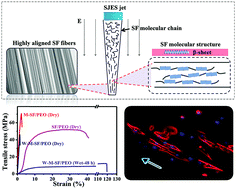Fabrication of high performance silk fibroin fibers via stable jet electrospinning for potential use in anisotropic tissue regeneration†
Abstract
Regenerated silk fibroin (SF) from Bombyx mori silkworm cocoons is a highly regarded natural protein-biomaterial suitable for engineering a variety of biological tissues. Electrospinning offers a unique approach to fiber formation that can readily produce micro- and nano-scale fibers recapitulating the ultrastructure of a native extracellular matrix. However, SF fibers from conventional electrospinning suffer from the problem of poor mechanical properties for load-bearing relevant tissue regeneration applications. In this study, highly aligned high-strength SF fibers were fabricated by a recently emerged stable jet electrospinning (SJES) approach, with the aid of high molecular weight poly(ethylene oxide) (PEO) acting as a fiber-forming ingredient to increase control over the jetting instability during electrospinning. The results showed that 90% of the collected SF/PEO (mass ratio 88 : 12) fiber assembly via SJES oriented unidirectionally with an angle variation of <1° and displayed obvious anisotropic wettability. Mechanically, the as-electrospun highly aligned SF/PEO fibers exhibited a 22.0-fold increase in ultimate tensile strength (50.85 ± 1.13 MPa) and a 49.3-fold increase in Young's modulus (1185.99 ± 164.56 MPa) compared with the randomly oriented SF fibers. A subsequent methanol treatment further remarkably boosted the tensile strength to 73.91 ± 5.15 MPa and Young's modulus to 2426.13 ± 86.67 MPa. The mechanical performance of the SF fibers via SJES was also impressive, even when tested in the wet state. The substantial improvement in the mechanical properties of the electrospun SF fibers is attributed to the SJES-enabled higher molecular orientation and contents of the secondary structure (α-helix and β-pleated sheet), as well as the high degree of fiber alignment. Moreover, biological tests verified that these SF-based fibrous scaffolds supported the induced pluripotent stem cell derived mesenchymal stem cells to adhere, migrate and grow in a manner of orienting along the fiber axis. We speculate that these high-performance biomimicking SF fibers might give rise to improved efficacy while being utilized to architecturally regenerate anisotropic load-bearing tissues (e.g., tendon, ligament, and blood vessel).



 Please wait while we load your content...
Please wait while we load your content...